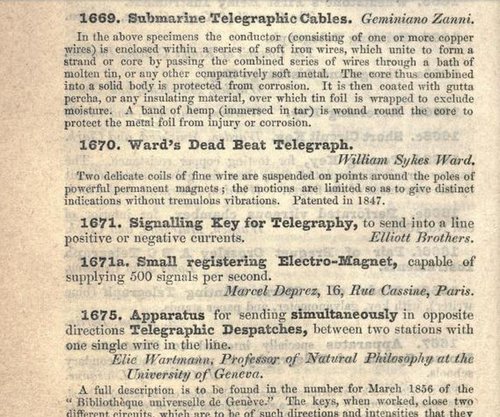Scientific Apparatus Exhibition
King’s College, London contributed items from the Wheatstone
Bequest to an exhibition of 1876 designed to increase popular knowledge of
science. The Special Loan Collection of
Scienti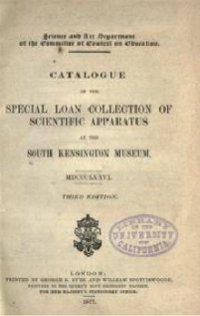 fic Apparatus was organised by the British Government under the aegis of
the South Kensington Museum. It was
called ‘vast and important’ by The
Popular Science Review.[i]
There was not sufficient space for the more than 4,500 exhibits at in the main
South Kensington Museum buildings so the exhibition was set up in the range of
buildings on the west side of the Royal Horticultural Association Gardens
adjoining Prince Albert Road.
fic Apparatus was organised by the British Government under the aegis of
the South Kensington Museum. It was
called ‘vast and important’ by The
Popular Science Review.[i]
There was not sufficient space for the more than 4,500 exhibits at in the main
South Kensington Museum buildings so the exhibition was set up in the range of
buildings on the west side of the Royal Horticultural Association Gardens
adjoining Prince Albert Road.
From the
outset the supporters of the exhibition had the idea that a permanent science
museum could result from this display of temporary loans though, in the event, the
independent existence of the Science Museum was not officially recognised until
June 1909. New buildings were
constructed on the current site in the period 1913-28.[ii] The exhibition of 1876 was marked by the
decision to organise it primarily on the basis of topics of scientific enquiry rather
than introduce geographical or national
Telegraphy featured in the West Courts of the exhibition
building with light-house apparatus, mathematics, meteorology and
astronomy. Here was a compressed
history: ‘the methods of science’ in electrical messaging had an abbreviated
span in comparison to astronomy, for instance.
It was nonetheless presented as a history, with the inclusion of the
early apparatus and instruments devised by Wheatstone (a number sent by King’s
College, London), and subsequent elaborations and sophistications of the
equipment. subsections. International participation 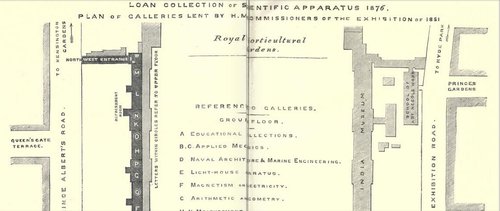
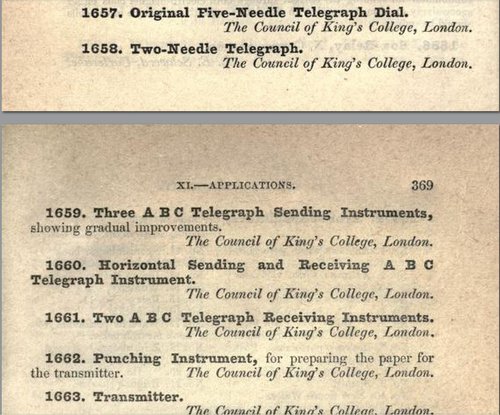
The knowledge imparted was about the kind of problem solving undertaken by scientists. The exhibition as a whole ‘cannot fail to awaken a very general interest in those means of abstract scientific research of which the public know so little’, claimed the Academy. The direct effects of the exhibition were amplified by extensive press coverage. Practical demonstrations occurred at set times, and free lectures by eminent scientists were a notable feature of the exhibition. Labels in the exhibition were barely adequate, critics said, but the information in the Catalogue was extensive and substantial essays by authoritative men of science featured in the Handbook.[ix] Consistently good attendance at the lectures was noted.[x] Expectations as to attendance may have been set unreasonably high by an implicit comparison with International Exhibition attendance; there were some indications of disappointment. Nature recorded visitor numbers of 11,715 in the week ending July 15th 1876 which is not negligible.[xi] The exhibition closed very suddenly in December 1876; apparently winter attendance had dropped off in comparison to the autumn and the economics of keeping it open were problematic. Underlying issues about the future of the project including mechanisms for purchasing or seeking retention of exhibits, and housing them in the long term, were also involved.[xii]
In drawing attention to this exhibition Scrambled Messages questions the view of the Athenaeum which sneered at the way the daily press was ‘driven wild with enthusiasm’ over the exhibition. For the embittered Athenaeum reporter the rather worthless exhibition was a collection of ‘brass, glass and old iron relics’. An alternative view is that the ‘relics’ were historical items that stimulated thinking about process. In the case of telegraphy the instruments
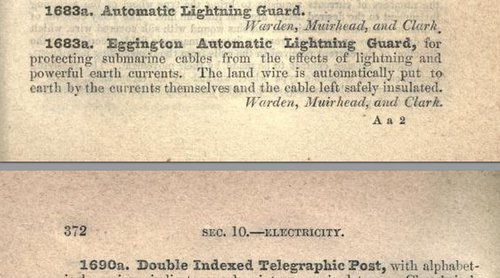
were drawn from an intense recent history of problem solving. The mathematician William Spotiswoode commented on the ongoing conundrums and obstacles that faced scientists in the remarks he made when chairing one of the conferences associated with the exhibition. The image he used was of cloudiness. ‘Again, an Exhibition of this kind is useful in bringing to light the actual operations of the scientific world, the problems which have been solved and others which are still in a nebulous condition with just here and there a clue peeping out’.[xiii] For the visitors to the exhibition the process of deduction was what was on offer, conceived of as starting from reduced visibility, relating to an apparently shapeless entity rather than the hard forms of brass and glass.
[i] Popular Science Review, 15.58 (Jan 1876), p. 311.
[ii] http://www.sciencemuseum.org.uk/about_us/history.aspx consulted 25 Mar 2015
[iii] Popular Science Review, 15.58 (Jan 1876), p. 311.
[iv] Examiner, 13 Jan 1877, p. 40.
[v] Athenaeum, 1 July 1876, p. 19
[vi] Analyst, vol. 1, no. 3, p. 54.
[vii] Academy, 20 May 1876, p. 487.
[viii] Catalogue of the Special Loan Collection of Scientific Apparatus at the South Kensington Museum, London 1876, third edition, pp. 371-3
[ix] Catalogue of the Special Loan Collection of Scientific Apparatus at the South Kensington Museum, London 1876; Handbook to the Special Loan Collection of Scientific Apparatus, London 1876.
[x] Examiner, 13 Jan 1877, p. 40; Nature, 5 April 1877, p. 490.
[xi] Visitor total for a week at International Exhibition, early November 1862, was 319,041, http://archive.thetablet.co.uk/article/8th-november-1862/12/the-international-exhibition-closed-on-saturday-th
[xii] British Architect and Northern Engineer, 5 Jan 1877.
[xiii] William Spottiswoode as reported in Saturday Review as reported in Nature, 25 May 1876, p. 77.

